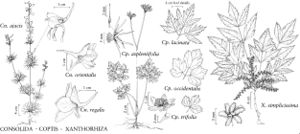Consolida ajacis
Verh. Mitth. Siebenbürg. Vereins Naturwiss. Hermannstadt 4: 47. 1853.
Stems 3-8 (-10) dm, glabrous to sparsely puberulent. Leaves 5-20 or more. Leaf-blade orbiculate, 12-60-lobed or more, 1-5 cm wide, glabrous to puberulent, lobes less than 1.5 mm wide. Inflorescences 6-30 (-75) -flowered, simple or with 3 or fewer branches; bracts (at least lowermost 2) with 5 or more lobes; pedicel ascending-spreading, 1-3 (-5) cm, ± puberulent; bracteoles not touching sepals, 4-20mm from flower, ± linear, 1-3mm, ± puberulent. Flowers: sepals blue to purple, rarely pink or white, nearly glabrous, lower sepal 8-18 × 4-8mm, lateral sepals 8-18 × 6-14 mm, spur 12-20 mm; petals of same color as sepals or whiter, lateral lobes 3-6mm, terminal lobes 5-8 × 2-4 mm, sinus 0.2-1 mm. Follicles 12-25 mm, puberulent.
Phenology: Flowering summer.
Habitat: Waste places, old homesites, drainage ditches, roadsides, and railroads
Elevation: 0-2000 m
Distribution

Introduced; B.C., Man., Ont., Ala., Ariz., Ark., Calif., Conn., Del., D.C., Fla., Ga., Ill., Ind., Iowa, Kans., Ky., La., Md., Mass., Mich., Minn., Miss., Mo., Mont., Nebr., N.C., N.Dak., N.J., N.Y., Ohio, Okla., Pa., R.I., S.C., Tenn., Tex., Vt., Va., W.Va., Wis., native to Europe and Africa, in Asia and Australia
Discussion
In many floras the names Consolida ambigua (Linnaeus) Ball & Heywood and Delphinium ambiguum Linnaeus have been misapplied to this taxon.
Consolida ajacis has escaped and become more or less naturalized in many temperate and subtropical parts of the world. It is by far the most commonly encountered species of Consolida in North America.
The Cherokee used Consolida ajacis medicinally in infusions to treat heart problems (D. E. Moerman 1986, as Delphinium ajacis).
Selected References
None.
Lower Taxa
"dm" is not declared as a valid unit of measurement for this property."dm" is not declared as a valid unit of measurement for this property.
